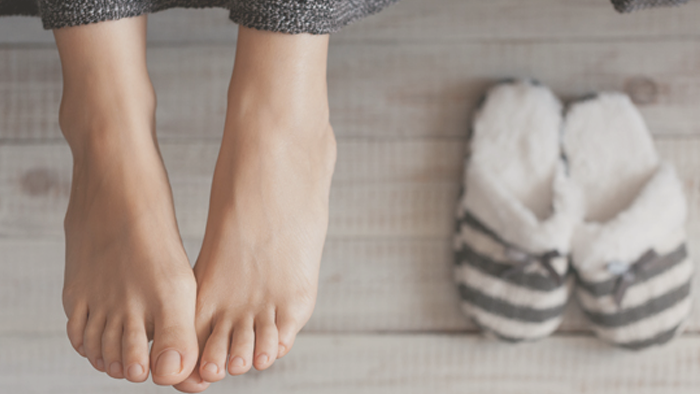
03 Jan The Curse of Cold Feet
Sometimes, no matter how many pairs of wool socks you wear, your feet just can’t seem to warm up. If you’re relatively healthy, chances are the cause of your cold feet is likely something harmless. In fact, cold hands and feet reflect a perfectly natural process by which the body keeps your vital organs safe and warm and if you’re a woman, then you are likely to experience this. A study revealed that women are up to nine times more likely to suffer from cold hands and feet than men. This is because women have more evenly distributed fat layers, providing internal insulation, and as a result, the blood supply favours protecting core organs and trunk over extremities, meaning less blood flow to the hands and feet! Men on the other hand have more heat-generating muscle mass, better supplied by blood vessels, increasing blood flow and, therefore, warmth.
Nonetheless all of us—men and women—feel cold when our skin gets cold.
Thermo-receptor cells, less than a millimetre below the surface of the skin, are what cause us to experience changes in temperature. Normally, the skin is kept at a comfortable temperature thanks to blood pumping through the capillaries—tiny, branch-like blood vessels that make up our microcirculation. But when the thermo-receptors detect cold, they react by causing the capillaries to shut down, diverting blood flow—and warmth—to the heart, lungs and other internal organs. This process is called vasoconstriction. Incredibly, when we’re cold the amount of blood flowing into the skin in the extremities can become as low as 0.02 litres per minute (the maximum rate is two to three litres per minute).
So although women may feel the cold more than men, it’s actually their skin temperature—not their core body temperature—that’s colder.
Indeed, a study of 219 people published in The Lancet in 1998 showed that while the body temperature of the women who were studied was on average 0.4 degrees hotter than the men, their hands were 2.8 degrees colder!
This could also be partly down to hormones. In women, the female hormone oestrogen regulates the peripheral blood vessels; high levels of this hormone make them more sensitive to temperature. As a result, a woman’s temperature will vary during her menstrual cycle as oestrogen levels rise and fall.
Other Causes of Cold Feet
But apart from these, there could be different and more serious reasons as to why you may be suffering from feet that always seem to be cold:
- Diabetes: Excess sugar in the blood damages the blood vessels and slows down circulation. Poor blood circulation, leading to cold feet, is common among diabetics.
- Nerve Damage: When the nerves of the feet are damaged, they stop sending signals to the brain and spinal cord, which means they no longer react to maintain good blood supply. If you suffer from insensitivity in the toes, it is common that you suffer from cold feet.
- Raynaud Phenomenon: This is an excessive contraction of the blood vessels that prevents proper circulation to the fingers and toes.
Symptoms to watch for include:
- Thickened toenails
- The absence of hair below the knees
- Cramping pain in the calves when walking
- Blue feet
- Tingling, pain, or burning sensation in the feet
- Heightened sensitivity to touch
As the reasons for cold feet could differ from person to person, it is important to visit your doctor and clarify what is causing the condition before attempting to treat it.
Simple Remedies
The only sustainable way to solve the problem of cold feet is to improve your blood circulation. Here are 6 simple remedies we recommend:
- Foot massages: They are a natural and therapeutic measure to restore proper circulation and warmth to your feet, especially when practiced daily. Using sesame or olive oil, massage the soles of feet before going to bed, and after the massage, cover them with cotton socks!
- Light Exercise: Walking and being physically active in general allows for better blood circulation and acts as natural massage through contractions/relaxations of the muscles, which help to improve blood circulation.
- Hydrotherapy: This is one of the simplest of remedies that you can try at home to restore warmth to your feet by simply immersing them in hot (but not burning) water, as the heat will dilate the blood vessels and improve blood circulation. Fill two basins, one with cold water, the other with hot water and begin by immersing your feet in the cold water basin for two minutes, and then placing them in the warm water for one minute. You can also mix a few drops of ginger, rosemary, peppermint or cypress essential oil in the water. Repeat this immersion process 6 times as the alternating contraction/dilation of your blood vessels will help to improve circulation. Just remember to remain upright and active after this hydrotherapy session in order to maintain blood circulation.
- Ceasing Bad Habits: Stopping smoking and decrease sugar intake, as both cause severe damage arteries.
- Diet: Eating fish rich in omega-3 (which aid with clearing arteries and improving circulation) and coloured berries such as blueberries, blackcurrants, hawthorn, cranberries (antioxidants that are beneficial to the circulatory system) will help to remedy cold feet. You can also mix pepper, ginger, garlic and ginkgo biloba together as they work as a perfect blend for blood circulation.
- And lastly, while an obvious solution – wear warm socks!
